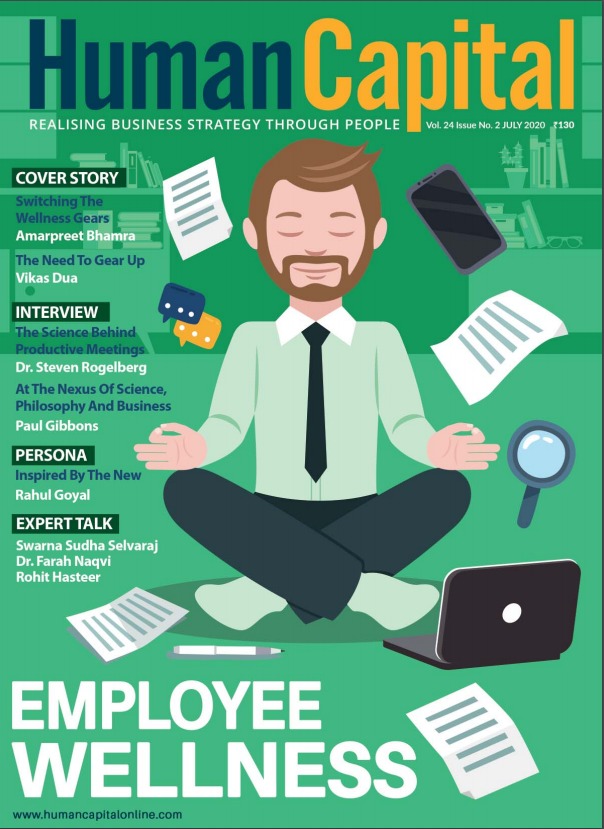A hybrid workplace model is a combination of remote and in-premise employees. Sounds complex? Read on to find out how you can have the best of both worlds.
The future of the workplace has been the talk of the town, though what we are witnessing is a shift in day-to-day operations. Just a year back, working from home was treated as a privilege for employees, primarily in organisations operating in India. Overseas business travel was quite frequent and was considered necessary to derive the desired outcome. An in-person meeting with candidates was required to close an open position. Online learning was always a part of an employee's upskilling plan; however, more stress was placed on classroom training.
Within a year, the corporate world experienced a paradigm shift and has been adjusting to the new normal ever since. Each one of us has realised that COVID is not going away anytime soon. The show must go on, as they say, but not at the expense of people's safety and lives. Organisations must focus on an operating model wherein people feel safe and are given flexibility. Earlier, organisations debated the viability of working from home. However, it was the only option available last year. This shift called into question how organisations had been operating for decades. Even the facilities and areas we never imagined could operate through a remote working setup were pushed to adapt. It was a successful transformation in most areas.
The lockdown we see today is pretty different from what we experienced last year, and the world is not at a complete halt. The pandemic has altered the thought process of the workforce and organisations; remote working is no longer a challenge. Employees are more at ease when they are given flexibility and autonomy at work. Organisations, on the other hand, must strike a balance between meeting organisational goals and their employees' happiness index. As a result, businesses have begun to consider the hybrid workplace model.
A hybrid workplace model is a combination of remote and in-premise employees. Sounds complex? Yes, it's going to be tricky because the organisations and HR professionals will now have to balance two different sets of the workforce at the same time. However, when managing difficult situations, it is always good to plan wisely. The following are some key points to consider when implementing a hybrid workplace strategy:
• Understand your business – The first step in implementing any new way of working is understanding your business from an operational standpoint. Analyse your business value chain and identify the ratio of your remote and in-premise workforce.
• Understand your employees' needs – In these trying times, it is imperative to understand and be conscious of your employees' needs. Break your workforce into smaller groups to better understand the on-ground challenges. Today's workforce seeks flexibility, wherein instead of spending their time on the road, travelling back and forth from their workplace, they want to invest in quality time managing their families. While you work to understand your employees' needs, you should also be focusing on driving the business objectives by engaging the employees and making them feel included.
• Focus on collaboration – Collaboration can make or break your hybrid working model. Make sure you're focusing on technological advancement to make your employees feel connected and focused on a shared purpose. HR and technology need to collaborate first to ensure that people stay connected with one another and work towards a shared goal.
• Conduct unbiased performance management – As we talk about the hybrid workplace model, it is important to understand that not all employees are able or willing to return to the workplace. This is a choice we have to give to them. Ensure that you create a level playing field for each employee wherein oranges are not compared with apples. Equal opportunity must be given to all the employees, whether they are working remotely or on-premise. Performance reviews and appraisals are to be outcome-driven, not location-driven.
• Embed in your culture – Higher management and HR professionals must ensure that a hybrid working model is ingrained in the organisation's culture. HR professionals need to focus on every employee to retain them and enable their growth within the organisations. Again, technology will be critical because it is the only way to engage and collaborate with a remote workforce.
• Put employee safety first – While creating a hybrid working model, employee safety should be given precedence. Organisations must focus on making employees feel safe when they return to the workplace. Conduct employee to understand their comfort level, focus on risk assessment for the workforce demographics, implement new protocols while keeping COVID-19 guidelines at the centre, and connect with medical professionals and organisations to fully understand the required measures. Ensure that a safety plan is made available to all employees as a bible and embedded into the organisation's culture.
• Make communication the key – Communication is pivotal in managing any change. Ensure that the plan is communicated to employees in the most transparent way possible and that each employee understands "what's in it for me".
A hybrid workplace model will be how organisations plan, organise, structure, manage, and develop their workforce. The viability of remote working is no longer in doubt, nor is its effectiveness a variable to be concerned about. This pandemic has challenged the ways we have been working for years. The work and workforce dynamics are changing rapidly, so let us embrace the change and be prepared for it.

Dakshdeep Singh is an HR Tech evangelist and an experienced solution architect. He leads Customer Success efforts at PeopleStrong – Asia’s most popular HR Tech brand. In a career spanning over 10 years, he has helped over 80 customers transform their human capital management. He has also been identified among the Top 100 HR Leaders under 40.

Priyanka Sharma is an HR professional with 8-plus years of vivid experience in HR Shared Services, HR Process Outsourcing, and HR Process & System Transitions. She acts as a catalyst to support organisations move up the value chain by digitising their HR processes while keeping employee experience at the centre. She is currently working with WOOD PSN as Service Delivery Lead.
Is your organisation post-COVID-ready?
Trending
-
SBI General Insurance Launches Digital Health Campaign
-
CredR Rolls Out 'Life Happens' Leave For Its Employees
-
Meesho Announces 30-Week Gender-Neutral Parental Leave Policy
-
Microsoft Unveils Tech Resilience Curriculum To Foster An Inclusive Future
-
60% Indian Professionals Looking For Job Change Due To COVID: Survey
-
SpringPeople And Siemens Collaborate For Digital Transformation Push
-
86% Professionals Believe Hybrid Work Is Essential For Work Life Balance: Report
-
Almost 1 In Every 3 People's Personal Life Affected Due To Work Stress
-
Meesho Rolls Out Reset And Recharge Policy For Employees
-
80% Of Talent Leaders & Academics Say Pandemic Changed Skill Needs For Youth: Report
-
Hero Electric Rolls Out 'Hero Care' Program For Employees
-
Human Capital In Collaboration With ASSOCHAM Hosts Virtual Conference
-
IKEA India, Tata STRIVE Collaborate To Create Employability And Entrepreneurship Opportunities
-
SAP India, Microsoft Launch Tech Skilling Program for Young Women
-
DXC Technology, NASSCOM Collaborate For Employability Skills Program
-
Lenskart To Hire Over 2000 Employees Across India By 2022
-
Mindtree Launches Learn-and-Earn Program
-
Tata AIA Extends 'Raksha Ka Teeka' To Its Employees
-
Swadesh Behera Is The New CPO Of Titan
-
NetConnect Global Plans To Recruit 5000 Tech Professionals In India
-
Hubhopper Plans To Hire 60% Of Indian Podcasters By 2022
-
Corporate India Needs More Women In Leadership Roles: Report
-
Aon to Invest $30 Million and Create 10,000 Apprenticeships by 2030
-
Tech Mahindra Launches ‘Gift a Career’ Initiative for Upskilling of Youth
-
40% Women Prefer Flexible Working Options in Post-COVID World: Survey
-
3 out of 4 companies believe they can effectively hire employees virtually: Report
-
Vodafone , CGI and NASSCOM Foundation launch digital skills platform
-
Odisha: Bank, postal employees to deliver cash for elderly, differently-abled persons
-
Skill India launches AI-based digital platform for "Skilled Workforce"
-
Hiring activity declines 6.73% in first quarter: Survey
-
70% startups impacted by COVID-19 pandemic
-
Bajaj Allianz Life ropes in Santanu Banerjee as CHRO
-
Over 70 Percent MSMEs look at cutting jobs to sustain businesses
-
93 Per Cent employees stressed about returning to office post-lockdown
-
Johnson & Johnson India announces family benefits for same gender partners
-
Indian firms turning friendly towards working mothers
-
Welspun India names Rajendra Mehta as new CHRO
-
Wipro partners with NASSCOM to launch Future Skills platform



Human Capital is niche media organisation for HR and Corporate. Our aim is to create an outstanding user experience for all our clients, readers, employers and employees through inspiring, industry-leading content pieces in the form of case studies, analysis, expert reports, authored articles and blogs. We cover topics such as talent acquisition, learning and development, diversity and inclusion, leadership, compensation, recruitment and many more.
Subscribe Now












































Comment